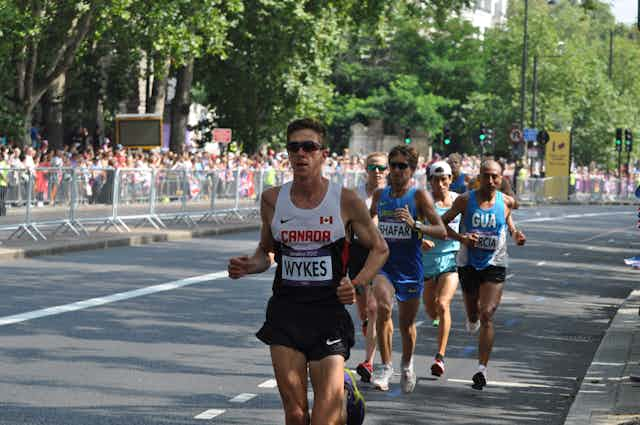The 15th Athletics World Championships, which open on August 22 in Beijing, China, present a significant challenge for the organisers. Allegations in early August of mass doping among athletes mean any untoward behaviour will pose a threat to the integrity of the competition.
According to the media revelations, a third of endurance runners who won Olympic and world championship medals from 2001 to 2012 may have cheated by taking performance enhancers or by “blood doping”. More than 800 track and field athletes are thought to have returned abnormal blood tests, suggesting they were cheating with impunity.
The World Anti-Doping Agency (WADA) uses a battery of blood and urine tests to determine if athletes are cheating. A key tool is the biological passport program, which tests all athletes for doping and performance-enhancing drugs.
Blood doping
Blood doping increases the blood’s ability to carry oxygen. This can have a direct impact on VO2max, the measure of a person’s aerobic capacity. Ultimately, blood doping is one of the more effective illegal ways of improving endurance performance.
Athletes blood dope by either using blood transfusions or specific drugs to increase their red blood cell count (haemoglobin). When they transfuse blood into their bodies, they can re-infuse their own blood (autologous) or use blood from another person who serves as a donor (homologous).
And when blood is taken out of the body and used for transfusions, up to four components, including red blood cells, platelets, plasma and cryoprecipitated antihemphilic factor (AHF), are removed from the sample and then frozen. Typically the red blood cells are returned to the athlete’s body when the sample is re-infused, in order to increase their ability to carry oxygen.
When athletes re-infuse their own blood, there’s no direct way of detecting what they’ve done. But indirect detecting methods are available, such as measuring their total haemoglobin mass (red blood cell size) or metabolites of blood bag plasticisers (by-products of the container the blood is stored in).
If the athlete transfuses someone else’s blood, drug testers can look directly at the antigen pattern of the red blood cells to detect doping. Since everyone has a different genetic code, doping is easily spotted when red blood cells present different genetic markers.
Testers can also indirectly look for the presence of plasticisers in urine tests. Because stored blood is exposed to plasticisers and their metabolites, they can be detected when expelled through urine.

As you can see, the combination of both blood and urine analytic techniques is very useful in detecting potential doping infractions involving blood transfusions.
Erythropoietin (EPO)
Another common method of doping is the use of recombinant human erythropoietin (rHuEPO), which stimulates the production of red blood cells. Erythropoietin (EPO) is a naturally occurring hormone found in the blood; recombinant EPO is the artificial version.
EPO’s ability to increase the number of red blood cells results in a dramatic increase of oxygen in the blood, which boosts athletic performance. Originally produced to treat several forms of chronic anaemia, EPO has been the source of numerous doping scandals in sport, especially in endurance sports such as cycling, distance running and cross-country skiing.
In addition to rHuEPO, athletes are likely to use erythropoiesis-stimulating agents (ERAs) such as FG-4592 (also known as Rodadustat). These are used to stimulate the body’s natural production of EPO in a fashion similar to training at altitude.
WADA added this compound to its testing regime only this year and athletes have already been caught using them. It’s likely many athletes have used these types of compounds before they were tested for, receiving a performance benefit without the risk of positive doping test.
Getting caught or evading detection
When the athlete’s blood samples are placed into the biological passport program, they are evaluated for changes in blood components (haemoglobin concentration; reticulocyte percentage; haemoglobin mass; reticulocyte count; red blood cell count; mean corpuscular volume; mean corpuscular haemoglobin; and mean corpuscular haemoglobin concentration) that are collectively used to assess if he or she may have blood doped.
After the athlete’s blood is thoroughly analysed, the data is used to calculate what has been termed the OFF Score (OFF-hr). This variable is calculated from the haemoglobin (a protein responsible for transporting oxygen in the blood) concentration, the reticulocyte (immature blood cells) percentage and an abnormal profile score.
If a suspicious or abnormal profile is determined with this calculation, the data is forwarded to a panel of doping experts who review it to determine if a doping infraction has actually occurred. If the panel deems that it has, WADA initiates a suspension process.
One way athletes appear to be circumventing the biological passports model is by small, frequent use of EPO. In 2011, Australian researchers found frequent micro-dosing allows athletes to use rhEPO without abnormal changes in the blood variables that are currently monitored by the athlete blood passport.
As the fight against doping continues, athletes appear to be continually searching for ways to elevate their performance and evade detection. The biological passport offers a great tool for limiting the practice of doping, but it seems that many athletes have already found ways to circumvent it.

